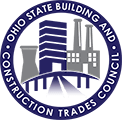PLAs are a win/win for the contractors and the workers.
Project labor agreements (PLAs) have been used since the 1930s and can be either voluntarily entered into by contractors on public or private projects, or they can be government-mandated. A PLA is an agreement between the contractor and the labor unions that establishes the terms and conditions of the work. It specifies wages and benefits to be paid, and it establishes procedures to resolve labor disputes which generally prevent the unions from striking and the contractors from locking out the unions. Often, a PLA will establish criteria for targeted hiring, which can ensure that local labor is used and that a specific percentage of the labor be minorities. As a result, PLAs benefit working men and women, contractors, communities and taxpayers.
The Ohio State Building and Construction Trades Council strongly supports the use of PLAs for a number of reasons:
- The contractor receives a reliable supply of highly trained, experienced workers
- Wages and benefits are uniform and clearly established through a single agreement ensuring smooth management
- PLAs ensure labor stability and increased productivity
- Labor disputes are settled peacefully
- Local labor means more construction dollars stay in the community
- Career paths are opened for minorities
- Contractors are ensured that their projects are completed on time and on budget
- Fewer accidents occur with a skilled workforce
- Workers receive livable middle class wages and benefits
A similar document is called a Community Benefits Agreement. CBAs generally guarantee that the majority of a project’s workforce comes from the local community and include recruitment and apprenticeship opportunities targeted to minorities, women and low-income residents. They also include provisions to hear and address community concerns. CBAs ensure that those affected by a project will participate in the planning process and all sectors of the community will benefit. Project owners benefit from CBAs by generating support from the community, while the community benefits from the increased job opportunities and economic impact.
